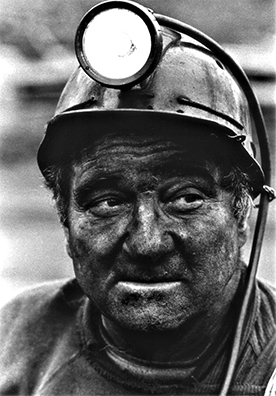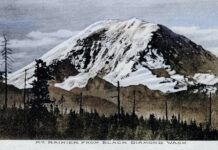The first Labor Day was celebrated on Sept. 5, 1882 in New York City. In 1887, Oregon, which formerly encompassed the Washington Territory was the first state to recognize Labor Day as a holiday. By 1894, twenty-three more states joined the movement. On June 28, 1894, Congress passed an act establishing the first Monday in September as a legal holiday. This coming weekend, Black Diamond celebrates Labor Day, and its coal mining roots with activities on Saturday, and Sunday, followed by the big parade down Highway 169 on Monday. For more information and a schedule of events visit: www.BlackDiamondLaborDays.org
Labor Day’s origins were focused on wages and working conditions, including employee safety. Hard hats were part of an ongoing effort to protect underground coal miners. In this photo from April 1975, Tony Basselli is seen wearing the then-current head protection commonly used in hazardous jobs. Basselli, age 62, was working at Palmer Coking Coal Company’s Rogers No. 3 underground coal mine which closed in December of the same year. Basselli labored in coal mines for over 44 years. Photo enhancements were provided by Andy Newell of Mancraft Graphics whose website is: www.MancraftGraphics.com/
During World War I, nearly ten million were killed on battlefields as modern artillery and high explosive shells obliterated countless during the era of bloody trench warfare. One saving grace from the front-line Armageddon was the soldier’s helmet that spared countless lives. A young lieutenant in the U.S. Army’s calvary witnessed the headgear’s effectiveness firsthand recognizing its potential in postwar industry. When Lt. Edward W. Bullard returned to his family business in 1919, he began developing a safety hat for workers. Founded by his father in 1898, the E.D. Bullard Co. of San Francisco manufactured carbide lamps and other mining equipment for the hard rock mines of California, Nevada, and Arizona.
Wartime helmets were made of metal and were too big and bulky for underground workers. They were also too expensive for a miner to afford. Bullard’s “Hard Boiled Hats” comprised of canvass and leather were sturdy, light-weight, and revolutionized workplace safety. For miners, a metal bracket was added to the front to hold a carbide or battery-powered lamp. In time, Bullard received 13 patents for his invention. Their popularity exploded after employers began requiring workers to wear hard hats while state and federal safety laws mandated their use.







